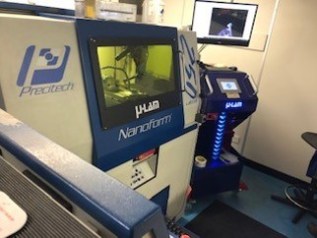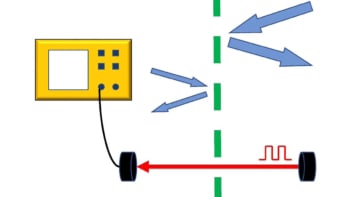Using a state-of-the-art laser-assisted diamond-machining system, ULO Optics and LBP Optics are developing a unique class of lenses to fine-tune the laser-cutting process for industrial steels

Innovative optical design and high-precision component manufacturing are at the heart of a UK industry collaboration that’s seeking to address the pervasive problem of edge corrosion in fabricated steel products – and in particular the steel plates destined for use in heavy-duty construction equipment such as excavators, dumpsters, backhoe loaders and the like. The EDGETECT2 R&D consortium, which is funded to the tune of £1 million by Innovate UK, the UK innovation agency, will action the findings from a previous feasibility study to develop next-generation optical components that are able to “fine-tune” the materials-processing capabilities of the high-power CO2 lasers and fibre lasers used for cutting and fabrication of high-added-value steel parts.
While that’s the technology end-game, the enabling materials science presents some considerable challenges for the EDGETECT2 project team. The application of paints and other anti-corrosion coatings over sharp steel edges typically results in the protective film pulling away during drying and curing – a phenomenon rooted in surface-tension effects. This, in turn, can lead to inadequate corrosion protection and rusting of the underlying steel surface, and especially so in the harsh conditions common to all construction sites.
Despite this effect being a well-known issue within the coatings industry, the commercial reality is that most laser-cutting processes are built for speed and throughput, resulting in highly sharp edges on processed steel plate. What’s more, no in-line technique exists to produce an edge geometry optimized for final coating, while manual edge-dressing processes are often too costly and time-consuming for the production environment.
From design to manufacture
The answer to this conundrum, it seems, may lie in a new class of dual-focus zinc-selenide (ZnSe) lenses being co-developed by two of the EDGETECT2 partners: LBP Optics and its parent company ULO Optics, a diversified UK optical components group specializing in the design and manufacture of infrared laser optics, thermal imaging optics and beam-delivery systems. The hope is that the ZnSe lenses, which represent a new addition to the LBP Optics product portfolio, will ultimately be incorporated into industrial laser systems to yield a cutting process that generates rounded edges in finished steel plates, such that the paint layer will be more even and retain an enhanced thickness at those edges.
“We work regularly with customers at the forefront of technology in their respective industries – from laser system OEMs to military, defence and aerospace contractors,” says Graham Allberrey, diamond turning consultant at LBP Optics. “To support the EDGETECT2 consortium, we are leveraging our recent investment in a state-of-the-art laser-assisted diamond-machining tool – one of only two such machines in the UK – so that we can achieve extended tool life on crystals such as zinc selenide and zinc sulphide, also cut materials such as fused silica that are otherwise unmachinable.”
Working alongside the two optics vendors in the EDGETECT2 collaboration are a global manufacturer of construction equipment and four other industry partners: Ultrasonic Cleaning Systems, which specializes in the preparation of cut steels prior to painting; Valspar Powder Coatings, an industrial paint and coatings manufacturer; Laser Expertise, a UK laser cutting and fabrication firm; and TWI, an independent research organization that focuses on engineering, materials and joining technologies.
Optical engineering
Twelve months into the EDGETECT2 work programme, which runs until April 2022, Allberrey and his team at LBP Optics have just delivered the first batch of prototype dual-focus ZnSe lenses. The components are based on a v1.0 design conceived by Nick Ellis, technical director at ULO Optics, and comprise a central portion of the optic shaped as per a conventional spherical lens to get the laser beam to a cutting focus. Meanwhile, the outer radial region of the lens incorporates a so-called “axicon”, a shallow conical surface to create a low-power, ring-shaped beam pattern intended to soften the edge of the cut steel.

Evaluation of the lenses is taking place on an R&D CO2 laser system at Laser Expertise. “This is a first-pass lens design and we’re expecting one or two more iterations at least,” says Ellis. “The lens will change the shape of the focused laser beam to divert some energy away from the main cutting area. Our hope is that this clever optical manipulation will soften the adjacent material and create a more rounded edge profile.”
In parallel, work is underway to develop a similar dual-focus lens for integration into a fibre-laser cutting system – in this case, to replace the optical window that’s used to prevent workpiece backspatter damaging the laser’s expensive optical subsystems. The material of choice in this application is fused silica, another exceptionally tricky substrate that will require the specialist capability of LBP’s laser-assisted diamond-machining tool. “We think the optical physics will be pretty much the same for both the CO2 and fibre laser systems, so if we get this dual-focus lens optimized for one laser technology we expect to be able to get it working on the other,” adds Ellis.
While EDGETECT2 is focused very much at the industry sharp-end, Allberrey points out that ULO Optics and LBP Optics also serve a diverse base of scientific customers carrying out applied optics R&D in a university setting. “EDGETECT2 is a great example of how we collaborate closely with all of our customers – industrial and academic – from the outset of a project,” he concludes. “We can machine a wide range of complex shapes to an extremely high degree of accuracy, such as the cylinders, torics and aspheric lenses that are being used more frequently in advanced laser systems.”
Diamond machining: a core competency



